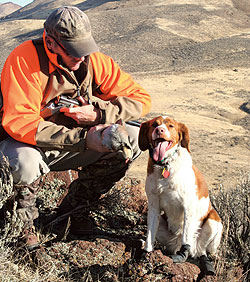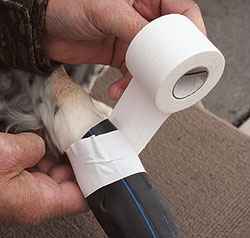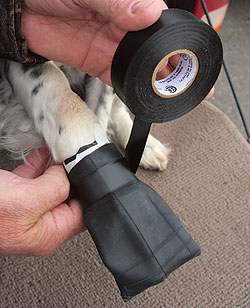Want a happy dog? Give him happy feet.
By Dave Carty
 Boots are almost a must in chukar country. |
I knew something was wrong the moment I dropped the tailgate. We'd spent the day chasing chukars in the rocky, vertical playing fields of southeastern Oregon, and after a 45-minute drive, we decamped at the fleatrap of a motel we'd rented, crumbling asphalt popping under the tires on the cratered drive, and swung open the doors to the dogs' airline crates. At that point — largely because it had happened hundreds of times before — I expected the dogs to charge out the back, two tired but happy-go-lucky, hyperkinetic bundles of white fur and enthusiasm. Instead, they tip-toed to the edge of the tailgate€¦and stood there.
This was puzzling, to say the least. We were halfway through our week-long trip, and the dogs had been bucking up well in what may be the most brutal — if desolately beautiful — uplands in the west. I had fitted my dogs with boots prior to each morning's hunt, but after several days they'd shown no wear at all on their pads, so that morning I decided to take them off. That, as it turned out, was a mistake. Eventually, I was able to coax Powder off the tailgate, but Scarlet wouldn't budge.
Frowning, I lifted her to the ground. Both walked gingerly to the room, as if treading on eggshells. I inspected their pads — again, for I'd done it at the end of the hunt — and again, they looked fine. No abrasions, no cuts. I didn't realize it at the time, but both dogs were on the verge of serious foot problems.
Dogs with sore feet often act exactly the way Powder and Scarlet did. Their feet were sore, as yours or mine would be if we hiked all day in uncomfortable boots, but they were not yet past the point of no return. There was still time to put the dogs up for a day's rest, or to boot them before allowing them to run again.
Unfortunately, I chose to do neither. Instead, I decided to hunt them — without boots--the following morning. That evening, I had two crippled dogs on my hands.
 Slip the boot (innertube) over the foot. |
Happy feet are what keep the part of a dog from the ground up operating smoothly. No matter how well trained he might be, no matter how bird crazy, a bird dog's feet can become so painful he'll simply quit hunting. I've had dogs whose feet hurt so much I had to carry them to the truck. Once they reach that point, your options are extremely limited.
By far the best solution is to never let them reach that point at all.
It's amazing how much can go wrong. Pads can become abraded on rocks, cut on farm implements or barbed wire or a zillion other things, stuck with sand burrs or the miserable and aptly named jumping cholla, or jammed with mud or snow. In my neck of the woods, one of the more common headaches is cactus, which some dogs seem to miraculously avoid and others never do learn to negotiate.
Scarlet, my setter, can run full tilt boogie through a cactus patch that would give a six-inch garter snake pause. I still don't know if she somehow manages to avoid the spines or simply doesn't care, but either way, the nasty little things just don't seem to bother her.
Powder and Hanna, on the other hand, my Brit and my youngest setter, will slow from a dead run to a dead walk until they can pick their way through a cactus patch. After years of trying to hurry them along, I finally threw in the towel and now steer my dogs away from the places where I know cactus will be a problem--even if it means passing up good bird habitat.
 Wrap it closed with white athletic tape. |
If there's a way to desensitize a dog to cactus spines, someone please tell me. Until then, the best plan is to go loaded for bear: carry forceps or a Leatherman tool (or both), and keep a sharp eye on your dogs. Dogs vary widely in how they react after being stuck; some will stop immediately and gnaw at their feet, while others will run all day with pads like pincushions.
The minute I spy one of my dogs chewing on her foot, I call her in and inspect it, hopefully before the spine has a chance to break off. Even tiny, hair-like spines can cause problems, so out they must come. I have a friend with a GSP who is so used to the drill that she'll simply stop in mid-stride, the offending paw in the air, until her owner arrives and doctors her feet.
Fortunately, most dogs develop tougher feet over the course of the season, and keeping them kenneled on concrete seems to help, although not a whole lot. Then again, maybe that's just me — I keep my three dogs in the house most of the time (and you're right, I'm not married), so any benefits they receive from their kennel time are negligible.
The way a dog runs, though, can have a huge effect on how long its pads hold up in the rough. Powder, who is stocky and probably 10 pounds heavier than Scarlet, nonetheless has far fewer foot problems. The reason: Powder isn't a sprinter.
Scarlet, on the other hand, is almost a case study in too much of a good thing. I love to watch her run — she flies around a wheatfield, a wisp of white smoke on four legs, then changes directions in midair to charge off and inspect a patch of cover a hundred yards distant.
 Fold the boot up over the foot. |
But all that bottle-rocketing around takes a toll on her feet. In rocky country she can grind her feet to a bloody mess in a matter of hours.
As a general rule — I'm big on general rules when it comes to canine foot problems — big, heavy dogs will abrade their pads more quickly than small, light dogs, but in my experience the biggest variable by far is terrain. In the upper Midwest, you can run your dog in the swampy grouse woods for days on end without problems. The soil is wet and soft, the logging roads are often covered with carpet-like growths of clover, and at least where I hunt the ground is dead
flat, which means my dogs rarely have to dig for traction.
Chukar land is exactly the opposite. There's probably more black Wisconsin soil stuck to the treads of my boots than there is in the entire eastern half of Oregon, but what states like Oregon and Idaho lack in soil, they more than compensate for in rocks. And rocks — especially the vertical kind — are hell on canine feet.
There are several things you can do to toughen them up. The first is to run your dog for several weeks or months prior to the hunting season. I rarely run my dogs on pavement, where they would probably develop tough feet more quickly, because I don't want to deal with the added risk of traffic. Still, even running a dog on dirt will toughen his pads a little.
The second is to condition the pads with a topical ointment like Tuf Foot. Tuf Foot smells suspiciously like the stuff my old high-school football coach used to rub on my blister-prone feet before practice, but it seems to work if you follow the directions, which explicitly state that you need to apply it for at least a couple weeks to see results.
 Wrap it again, now with electrician's tape. |
Another stopgap measure, although one I've not yet tried, is to smear a dog's sore (but not yet abraded) foot with super glue, then layer it with a cut-to-size piece of gauze bandage, which in effect forms a thin second skin. This was told to me by my old friend
Dr. Rick Allen of Jerome, Idaho, who has treated and hunted retrievers in the volcanic badlands around his home for years — some of the roughest country imaginable. The trick, he says, is to use it as a temporary fix, not a permanent one.
In the long run, nothing is as effective or as durable as dog boots. Over the years, I've tried half a dozen different types, with varying levels of success. The problem isn't in the protection they provide — they all do a good job of that — but in keeping the damn things on for more than an hour at a stretch. Since you can't buy just one boot, every time your dog throws one (and it goes without saying, you won't find it) he's just committed you to buying a new set, and at $25 to $35 a pop, that adds up. You can cut your losses by taping them on with electrician's tape, but even so your dog will probably throw one sooner or later.
Of the commercial boots I've tried, I've had my best luck with the black rubber boots made by Lewis (www. gundogsupply.com). Tape the dog's leg first (I use white athletic tape, which is easy to remove), which will prevent the boots from rubbing the leg raw, then tape over the outside of the boot with electrician's tape.
For the last couple of years, though, I've run my dogs almost exclusively in boots I make myself from bicycle innertubes (Giant brand mountain bike tubes, 26 X 2.35/2.75; 1.2 mm. thickness). They're dirt cheap: one $8.00 tube will make six or eight boots for my smallish setters.
 The finished result. |
Cut a piece about six or eight inches long and slit one end down an inch or two, then slide the slit end over and up the dog's leg. Pull the slits snugly together and tape the tube down just below the dog's dewclaw with white athletic tape, then grasp the free end (you should have four inches or so extending beyond the toes) and fold it up and over the foot.
Finish the job by taping around it once again with electrician's tape. When you wear holes in the bottom (about two days in chukar country) turn the tubes so the holes are up and you'll get another couple days' use out of them. Wrap your dog's feet with athletic tape first if the tubes rub his toes.
It isn't just rocks that will mess with a dog's running gear. Since I spend a good part of every season hunting in wet snow, my dogs are constantly stopping to chew the iceballs that form between their toes. I've tried everything I can think of to remedy the situation — clipping the hair between their toes, even smearing them with Vaseline. Nothing short of booting them will prevent a buildup, but running a booted dog in snow almost guarantees that he'll throw one or two of them. Unfortunately, I've had to resign myself to being stuck with the problem.
Finally, give your dog's feet the once-over at the end of each hunt. Look for cuts or abrasions, then watch how he walks after he's been fed and rested. Is he tip-toeing around? If so, you've got some deciding to do. It's a hassle to go through the process of fitting boots on your dog prior to a hunt, but it's far worse to have your pup pull up lame halfway through the trip you've spent all year convincing your boss is for your wife's high school reunion. You might want to think of it this way: take care of your dog's feet, and he'll cover for you.






